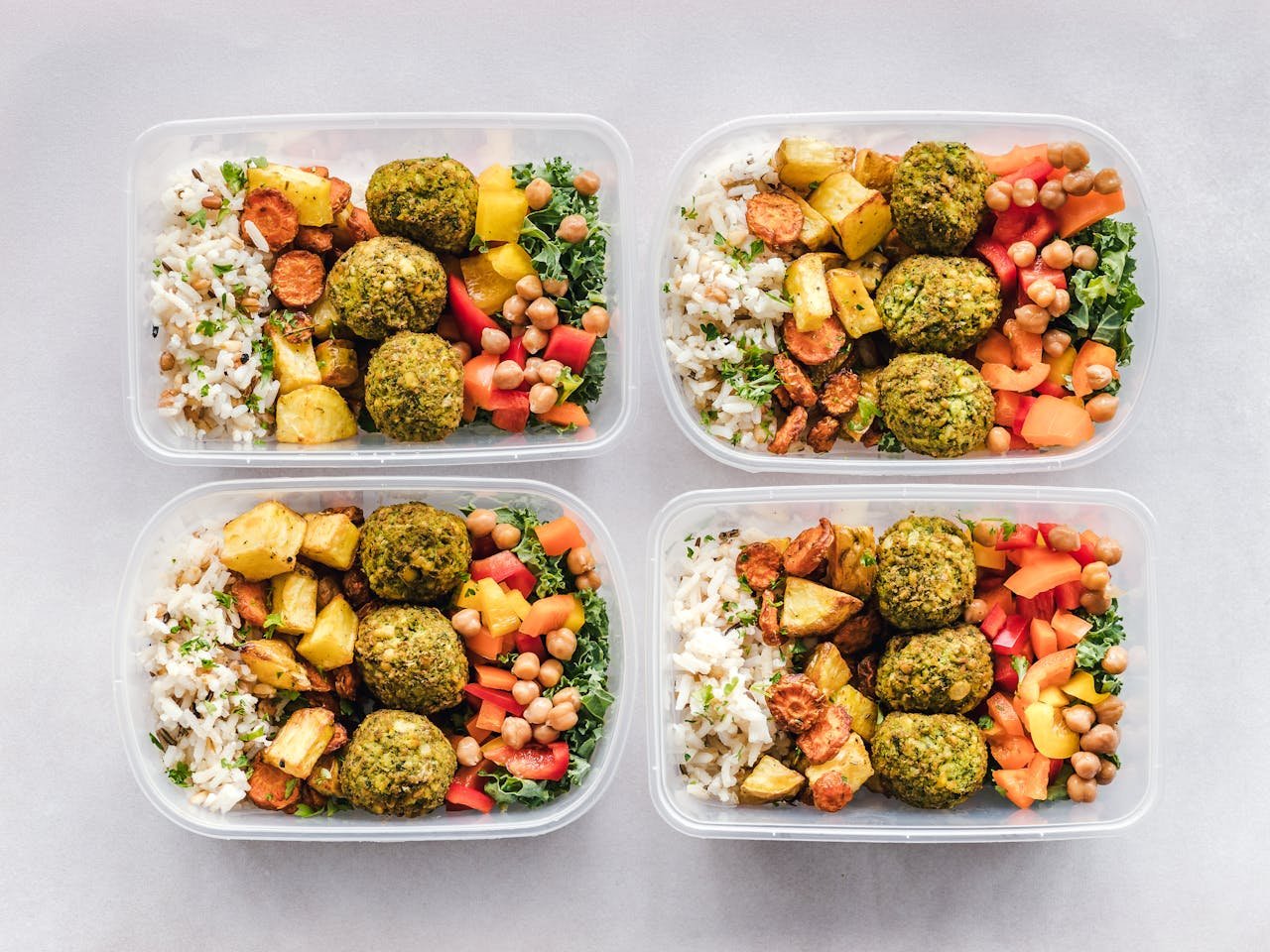Meal prep can transform your busy week. By spending just 30 minutes on Sunday, you can enjoy tasty, home-cooked meals every day. This simple habit saves time, reduces stress, and helps you eat healthier.
You don’t need to be a chef to meal prep. With a little planning and some basic cooking skills, you can create a variety of delicious dishes. Imagine opening your fridge to find ready-to-eat meals waiting for you after a long day.
Meal prepping isn’t just about cooking. It’s about making your life easier. You’ll spend less time in the kitchen during the week and more time doing things you love. Plus, you’ll save money by eating out less often.
Key Takeaways
- Meal prepping saves time and reduces weekday stress
- A 30-minute Sunday prep session can provide meals for the entire week
- You’ll eat healthier and save money by planning ahead
The Essentials of Meal Prepping
Meal prepping saves time and helps you eat well all week. It takes planning and the right tools, but the payoff is worth it. Here’s what you need to know to get started.
Understanding Meal Prep Basics
Meal prep means cooking large batches of food ahead of time. You can make full meals or just parts of meals. Start by planning your menu for the week. Pick recipes that use similar ingredients to save money and reduce waste.
Make a shopping list and buy everything you need. Set aside time on the weekend to cook. Sunday works well for many people. Aim to prep enough food for 3-5 days.
Cook proteins like chicken or beef in bulk. Roast a big pan of veggies. Make a large pot of rice or quinoa. Having these basics ready makes it easy to put meals together quickly.
Time-Saving Techniques
Use your oven to cook multiple things at once. Roast chicken and veggies on separate pans at the same temperature. While those cook, make a grain on the stovetop.
Chop all your veggies at once. Store them in containers in the fridge. This makes it easy to throw together quick stir-fries or salads.
Cook with a slow cooker or instant pot. These tools let you make big batches of soups, stews, and proteins with little effort.
Use frozen veggies and pre-cut produce to save time. They’re just as healthy as fresh and cut down on prep work.
Selecting the Right Containers
Good containers keep food fresh and make storage easy. Glass containers are best. They don’t absorb smells or stains. You can see what’s inside without opening them.
Pick containers that stack well in your fridge. Square or rectangular shapes save space. Make sure they’re microwave-safe for easy reheating.
Get containers in different sizes. Use small ones for snacks and sauces. Medium ones work well for individual portions. Large containers are great for storing big batches.
Look for leak-proof lids to prevent spills. Some containers have sections to keep foods separate. This is handy for lunches or portion control.
Planning Your Weekly Meals
A well-planned weekly menu saves time and ensures healthy, tasty meals. It helps you shop smarter and cook efficiently. Let’s look at key aspects of meal planning.
Nutritional Guidelines for Balanced Meals
Aim for a mix of nutrients in each meal. Include protein, complex carbs, and healthy fats. Add lots of veggies for fiber and vitamins.
Try to have 3-4 ounces of lean protein per meal. Good choices are chicken, fish, beans, or tofu. Fill half your plate with colorful veggies. Add a quarter plate of whole grains like brown rice or quinoa.
Don’t forget healthy fats. Use olive oil for cooking or add nuts to salads. Dairy or calcium-rich foods are important too. Include milk, yogurt, or cheese in some meals.
Seasonal Ingredient Selection
Picking in-season foods gives you the best taste and value. They’re often cheaper and more nutritious. Check what’s in season in your area.
Make a list of seasonal fruits and veggies. In fall, look for squash, apples, and pears. Summer brings tomatoes, berries, and peppers. Winter offers citrus and root veggies.
Plan meals around these seasonal stars. You’ll get variety throughout the year. It also supports local farmers and is better for the environment.
Creating a Flavorful Menu
Spices and herbs are key to tasty meals. Build a basic spice collection. Start with salt, pepper, garlic powder, and dried herbs like basil and oregano.
Try new flavor combos each week. Pair lemon and dill with fish. Use cumin and chili for Mexican-inspired dishes. Ginger and soy sauce work great in Asian recipes.
Don’t forget about sauces and dressings. Make a big batch to use all week. Try homemade salsa, pesto, or vinaigrette. They add zip to simple grilled meats or roasted veggies.
Prep Day Action Plan
A successful meal prep starts with a solid plan. You’ll save time and energy by prepping ingredients, cooking in batches, and storing meals properly. Let’s break down the key steps.
Ingredient Preparation
Start by washing and chopping all your veggies. Cut carrots, celery, and bell peppers into sticks for snacks. Dice onions and mince garlic for quick use in recipes. Wash and dry leafy greens like lettuce and kale.
Next, portion out proteins. Cut chicken breasts into cubes or strips. Divide ground beef into meal-sized portions. Cook and crumble bacon for easy adding to dishes.
Don’t forget grains and starches. Cook a big batch of rice or quinoa. Roast potatoes or sweet potatoes in large batches. Having these ready saves tons of time during the week.
Batch Cooking Strategies
Pick 2-3 main proteins to cook in bulk. Roast a whole chicken, slow cook a pork shoulder, or bake several salmon fillets. These can be used in various meals throughout the week.
Make a big pot of soup or chili. It’s easy to portion and freeze for later. Bake a large casserole that can be cut into individual servings.
Roast a tray of mixed vegetables. These can be added to salads, grain bowls, or eaten as sides. Prepare a large batch of pasta sauce or curry base for quick weeknight dinners.
Assembling and Storing Your Meals
Use clear containers to store prepped ingredients. Label each with contents and date. Stack similar items together in the fridge for easy access.
Assemble grab-and-go lunches in divided containers. Fill with a protein, veggie, and grain combo. Add a small container of dressing or sauce on the side.
Package individual portions of soups or stews in freezer-safe bags. Lay flat to freeze for easy stacking. Wrap burritos in foil for quick reheating.
Store cut veggies in water to keep them crisp. Use airtight containers for cooked grains and meats. Keep fresh herbs in jars with water, like flowers in a vase.

Effortless Execution During the Week
Meal prep saves you time and stress during busy weekdays. You’ll enjoy tasty, ready-to-eat meals with minimal effort.
Reheating and Serving
Reheating your prepped meals is quick and easy. Use the microwave for fastest results. Heat in 30-second bursts, stirring between each.
For oven reheating, preheat to 350°F. Cover your dish with foil and warm for 10-15 minutes.
Stovetop reheating works well for soups and stir-fries. Heat over medium-low, stirring often.
Remember food safety. Reheat thoroughly to 165°F internal temperature. Use a food thermometer to check.
Serve your meal on a nice plate. Add a side salad or fresh fruit for extra nutrition and visual appeal.
Quick and Easy Meal Enhancements
Boost your prepped meals with simple add-ons. Fresh herbs like cilantro or basil add flavor and color.
Try these quick toppings:
- Sliced avocado
- Crumbled feta cheese
- Toasted nuts or seeds
Squeeze lemon juice over fish or chicken dishes for brightness. Drizzle olive oil on veggies or grains.
Keep a few store-bought sauces on hand. Pesto, salsa, or hot sauce can transform a basic meal.
Mix in some frozen veggies for extra nutrients. They cook fast and require no prep.
Bon appetit!




